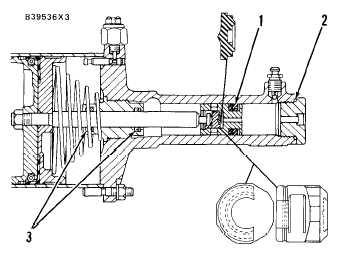A I R S Y S T E M A N D B R A K E S
CONTROL VALVE FOR EMERGENCY
AND PARKING BRAKE
T o o l s N e e d e d : 0 t o 1 3 8 0 k P a ( 0 t o 2 0 0 p s i ) G a u g e .
Make reference to WARNING on first page of
AIR SYSTEM AND BRAKES TESTING AND AD-
JUSTING section.
WARNING
1.
2.
3.
4.
5.
6.
7.
8.
9.
L O C A T I O N T O I N S T A L L G A U GE
1. Drain valve of the air reservoir.
Install a 0 to 1380 kPa (0 to 200 psi) gauge in
drain valve (1) of the air reservoir.
Start the engine and let the pressure go up to
cutout pressure 725 ± 14 kPa (105 ± 2 psi).
With the control knob for the emergency and
parking brake in the OFF position (pushed in),
stop the engine.
Push one of the brake pedals rapidly several
times, until the control knob automatically
moves to the ON position.
Read the pressure on the gauge.
The correct pressure to automatically engage the
parking brake is 275 ± 35 kPa (40 ± 5 psi). If the
pressure on the gauge is not correct, the opera-
tion of the control valve for the secondary and
parking brake is not correct.
Disassemble the control valve and check for
worn or damaged parts.
If this does not correct the problem, install a new
valve.
Remove the gauge.
TM 5-3805-258-24-1
T E S T I N G
A N D
A D J U S T I N G
BRAKE CONTROL VALVES
The application of the wheel brakes must be the
same when either of the brake pedals are pushed.
When the left pedal is pushed, the transmission is
disengaged and the brakes are activated. When the
right pedal is pushed, only the brakes are activated.
This is the only difference between the operation of
these pedals.
If the operation of the wheel brakes is not the
same between the two pedals, there is a failure in
one of the control valves. Repair or replace the
brake control valve that has failed.
LEAKAGE IN HYDRAULIC CIRCUIT
T o o l s N e e d e d : 9 S 7 6 9 2 I n v e r t e d F l a r e C o n n e c t o r .
1 / 8 i n . P i p e P l u g .
T a p e m e a s u r e .
Make reference to WARNING on first page of
AIR SYSTEM AND BRAKES TESTING AND AD-
JUSTING section.
Problem
Loss of brake fluid from the reservoirs can be
caused by one or more of the following reasons.
1. Leakage at hose or tube connections or leakage
through damaged hoses or tubes.
2. Leakage around seals (1), (2) or (3) of the mas-
ter cylinder. This leakage can be caused by in-
correct installation or a cut or damaged seal.
M A S T E R C Y L I N D E R
1. Seal. 2. Seal. 3. Seals.
4-61



